The automatic filling station search is activated More .
The fuel level in the fuel tank reaches the reserve fuel level.
The following notification is shown in the media display Reserve fuel Tap here to search for filling stations.
The automatic filling station search begins. The available filling stations along the route or in the vicinity of the vehicle's current position are displayed.
The address of the filling station is displayed.
The filling station is set as the destination or the next intermediate destination.
The filling station is entered in the route overview. Intermediate destination 4 is deleted. Route guidance begins.
Fuels are highly flammable.
Fuels are poisonous and hazardous to your health.
If you or other people come into contact with fuel, observe the following:
Electrostatic charge can ignite fuel vapour.
Vehicles with a diesel engine:
While the engine is running, component parts in the exhaust system may overheat without warning.
do not switch the ignition on. Otherwise fuel can enter the engine.
Even small amounts of the wrong fuel could result in damage to the fuel system and the engine. The repair costs are high.
do not switch the ignition on. Otherwise, fuel can enter the fuel system.
Even small amounts of the wrong fuel could result in damage to the fuel system and the engine. The repair costs are high.
If fuels are handled improperly, they pose a danger to persons and the environment.
the vehicle is unlocked.
the auxiliary heating is deactivated.
the ignition is switched off.
the front left-hand door is open.
Do not get back into the vehicle during the refuelling process. Otherwise, electrostatic charge could build up again.
Observe the notes on operating fluids More.
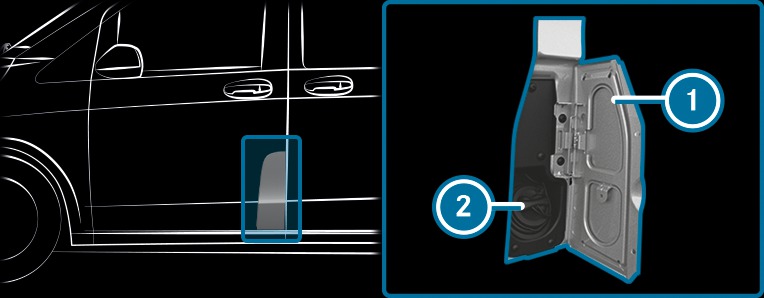


The fuel filler flap is beside the front left-hand door when viewed in the direction of travel. The position of the fuel filler cap  is also show on the instrument cluster. The arrow on the filling pump specifies the side of the vehicle.
is also show on the instrument cluster. The arrow on the filling pump specifies the side of the vehicle.
 .
.  anti-clockwise and remove it.
anti-clockwise and remove it.  and turn it clockwise.
and turn it clockwise. You will hear a click when the fuel filler cap is closed fully.
 .
. Vehicles with a diesel engine and incorrect fuelling protector against refuelling with petrol: the filler neck is designed for refuelling at diesel filling pumps for passenger vehicles.
Vehicles with a diesel engine without an incorrect fuelling protector: refuelling preferred at diesel filling pumps for passenger vehicles. However, you can also refuel at a diesel filling pump for lorries.
If the fuel tank has been run completely dry, top up with at least 5 l of fuel.
Vehicles that can use a mixture of fuels can be recognised by the sticker "Ethanol up to E85!" on the fuel filler flap.
The ignition is switched on.
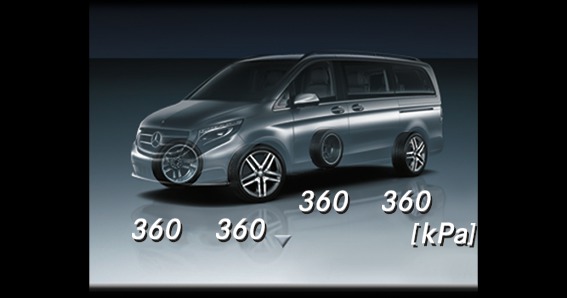
 button to call up the list of menus.
button to call up the list of menus.  or
or  button to select Service.
button to select Service.  button.
button.  or
or  button to select Tyre pressure.
button to select Tyre pressure.  button.
button. The display shows the current tyre pressure of each wheel.
If the vehicle was parked for longer than 20 minutes, the Tyre pressures will be displayed after a few minutes of driving message appears in the display.
Notes on tyre pressure More
The AdBlue® tank can only be filled as intended when the vehicle is parked on a level surface. This way, variations in the filling amount are avoided.
When filling the reservoir when the vehicle is standing at an angle, there is a risk of overfilling. This may damage exhaust gas aftertreatment components.
the auxiliary heating is deactivated.
the ignition is switched off.
the front left-hand door is open.
Refill AdBlue See Owner's Manual
The AdBlue® tank has dropped to the reserve level.
Refill AdBlue Emer. oper. in XXX km See Owner's Manual
The low AdBlue® level will result in limited performance after the remaining distance displayed has been driven. Refill AdBlue® as quickly as possible.
Emergency operation: 20 km/h No start in XXX km See Operating Instructions
Vehicle speed is limited to approximately 20 km/h. You will only be able to drive the vehicle the distance shown. Subsequently, it will no longer be possible to start the engine.
Refill AdBlue Engine start not possible
The vehicle can no longer be started.
You can also have the AdBlue® fill level and the AdBlue® range displayed More.
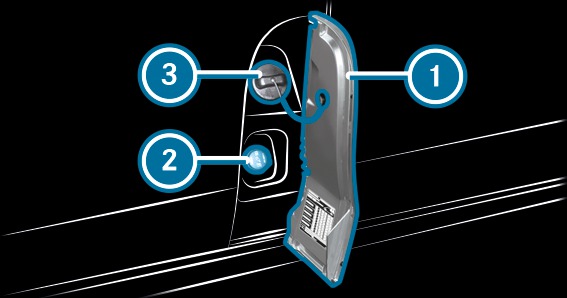
 .
.  anti-clockwise and remove it.
anti-clockwise and remove it. Fuel filler cap  for the fuel remains closed.
for the fuel remains closed.
The AdBlue® tank is completely full.
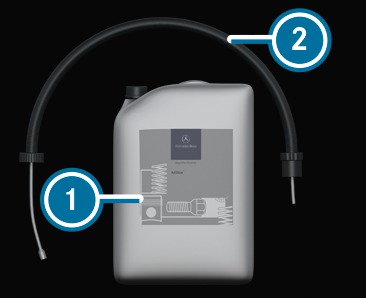
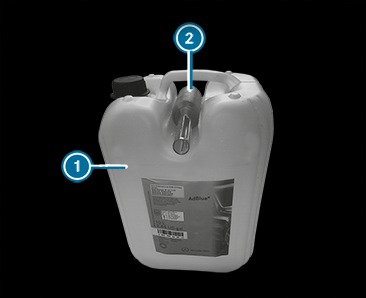
 .
.  onto the opening of AdBlue® refill canister
onto the opening of AdBlue® refill canister  until hand-tight.
until hand-tight.  onto the filler neck of the vehicle until hand-tight.
onto the filler neck of the vehicle until hand-tight.  .
. The filling process stops when the AdBlue® tank is completely full.
AdBlue® refill canister  can be removed when it has been only partially emptied.
can be removed when it has been only partially emptied.
Avoid storing AdBlue® containers permanently in the vehicle.
 and close AdBlue® and refill canister
and close AdBlue® and refill canister  in reverse order.
in reverse order. The filler neck is only locked correctly when this is the case.
The Refill AdBlue See Owner's Manual message in the multifunction display must go out after approx. 20 seconds. If the message continues to be displayed, you must add more AdBlue®.
If you open the engine bonnet when the engine has overheated or during a fire in the engine compartment, you could come into contact with hot gases or other escaping operating fluids.
Components in the engine compartment may continue running or start up suddenly, even if the ignition is switched off.
Make sure of the following before performing tasks in the engine compartment:
Windscreen washer concentrate is highly flammable.
Certain components in the engine compartment can be very hot, e.g. the engine, the radiator and parts of the exhaust system.
bonnet
dipstick
engine oil filler opening cap
washer fluid reservoir cap
coolant expansion reservoir cap
Unsuitable windscreen washer fluids may damage the plastic surface of the exterior lighting.
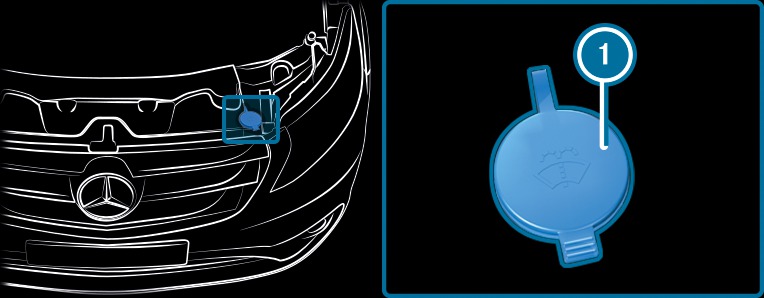
 of the washer fluid reservoir upwards by the tab.
of the washer fluid reservoir upwards by the tab.  onto the filler opening until it audibly engages.
onto the filler opening until it audibly engages. Mix the washer fluid with windscreen washer concentrate all year round. Observe the further information on windscreen washer fluid under "Operating fluids and capacities" More.
If the windscreen wipers begin to move while you are changing the wiper blades, you can be trapped by the wiper arm.
If the wiper arm on the windscreen or rear window is folded back before a wiper blade has been fitted, the window may be damaged by the force of the impact.
If the windscreen wipers have been folded back from the windscreen when the bonnet is opened, the windscreen wipers or the bonnet may be damaged.

 away from the wiper arm as far as it will go.
away from the wiper arm as far as it will go.  in the direction of arrow
in the direction of arrow  until it engages in the removal position.
until it engages in the removal position.  .
. 
 .
.  in the direction of arrow
in the direction of arrow  until it engages in the locking position.
until it engages in the locking position. 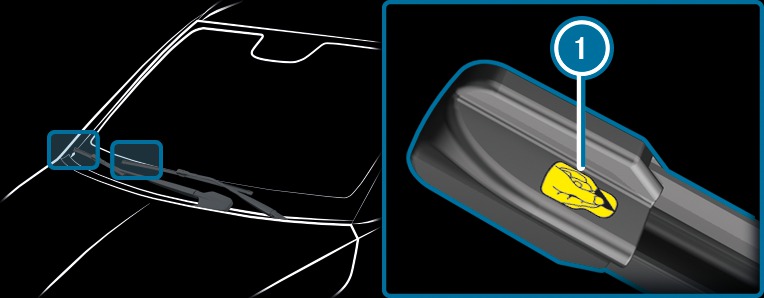
 from the maintenance displays on the tips of the newly fitted wiper blades.
from the maintenance displays on the tips of the newly fitted wiper blades. If the colour of the maintenance display changes from black to yellow, the wiper blades should be replaced.
The time until the colour changes varies depending on the usage conditions.
The engine oil level is determined during driving.
The engine is at normal operating temperature.
The vehicle is level during the measuring process.
The bonnet is not open.
Depending on the driving profile, the oil level can be displayed only after a driving time of up to 30 minutes and only when the ignition is switched on.
Engine oil level Measurement in progress...
Engine oil level OK
The bar for displaying the oil level on the display is green and is between "min" and "max".
Engine oil level Warm up engine
Engine oil level Correct measurement only if vehicle is on level ground
Engine oil level Add 1,0 l
The bar for displaying the oil level on the display is orange and is below "min".
The oil level is too low.
Engine oil level Reduce oil level
The bar for displaying the oil level on the display is orange and is above "max".
The oil level is too high.
For engine oil level turn on ignition
Engine oil level System inoperative
The fill level sensor is defective or not plugged in.
Engine oil level System currently unavail.
Braking efficiency is reduced after washing the vehicle.
the side windows and roof are completely closed.
the outside mirrors are folded in and an additional antenna is removed, if present.
the climate control blower is switched off.
the windscreen wiper switch is in position
 .
.
If the vehicle is very dirty, wash off excess dirt before cleaning the vehicle in an automatic car wash.
the outside mirrors are fully folded out again and an additional antenna is mounted again.
wax residues on the windscreen and wiper rubbers are removed to prevent streaking and reduce wiper noise.
Remove wax residues from the camera lens in vehicles with a reversing camera More.

